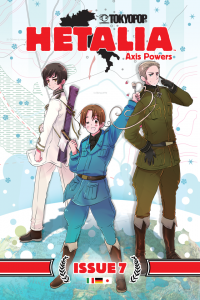The Stellar Six of Gingacho Volume 1 by Yuuki Fujimoto
The Stellar Six of Gingacho is set on a busy market street district, where the “Stellar Six” of the title are all middle school students who have grown up together while working at their family businesses. The main couple in the book are Mike, who is the daughter of a greengrocer and Kuro, a boy whose family runs a fish shop. At the opening of the market Mike and Kuro stage an acrobatic mock battle where they fight over what is better – fresh fish or daikon. The display reels the customers in to the market street. Mike and Kuro used to run together in a pack of children. There’s Sato, an otaku girl whose parents run a Yakitory stand. Iba’s parents run a rice stand, and she can heft an impressive amount of rice bags. Ikkyu uses his good looks and womanizing ways in his role of delivery boy for his family’s soba restaurant, and the group is rounded out by the oddly withdrawn Mamoru whose parents run the local liquor store. The group hangs out at the local bar before it opens officially, running up a tab for sodas and tea.
Mike is feeling wistful, but she’s not certain why. When the group of friends entered middle school they began to grow apart after being assigned separate classrooms. When everyone accidentally gets together in the bar, Mike realizes it has been a long time since the group has been in the same place at the same time. She embarks on a campaign for a group bonding activity – entering the traditional Japanese dance contest at the upcoming street festival, with her eye on the second place prize of free food. When the neighborhood bar gets vandalized, the group pulls together with the idea of winning the cash prize to help pay for repairs and their tab.
Mike isn’t yet facing up to the reality of adolescence and the possibility of her childhood friendship with Kuro changing into something else. The neighborhood setting of The Stellar Six gives it a different feeling than the many school-related shoujo series. While the antics of the kids are funny, the manga is also filled with a feeling of nostalgia about leaving childhood behind. All the adults on the street look after the children, and the children in turn keep tabs on residents that might need extra help or encouragement. This gives Stellar Six more depth and narrative interest than similar workplace shoujo manga like Happy Cafe. One of the greatest complements I can pay this series is that it feels a lot like a CMX title, with the same type of sweetness and deceptive simplicity that I found in their best shoujo titles. This isn’t a surprise since The Stellar Six was published by Hakusensha, source of many CMX and Tokyopop manga. The Stellar Six has a ton of heart, and while it might not be flashy, it is a perfect feel-good read.
Review copy provided by the publisher.

Recent Comments